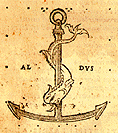
1502, Venice: ALDUS MANUTIUS
The poetry of the Comedy emerged from beneath a sea of exegetical
commentary for the first time in more than twenty years in this edition
produced by the most celebrated printer and publisher of Renaissance Italy,
Aldus Manutius. The text differed radically
from the Landino vulgate which had established itself during the last decades
of the 15th century. The text of the 1502 Aldine, which was to become the
vulgate for the next 300 years, was prepared by no less than the literary
arbiter of the Italian High Renaissance, the Venetian humanist and courtier
Pietro Bembo (1470-1547). Bembo is most familiar outside of Italy for his
Neoplatonic discourse on love in the last book of Castiglione's The Book
of the Courtier, or for Titian's majestic portrait of him (1540) shortly
after his elevation to the cardinalate.
Bembo had already prepared for Aldus in 1501 an influential edition of Petrarch's
Canzoniere. Together with his 1502 Dante, Bembo's editions of the
vernacular Italian classics represent the practical (and polemical) point
of departure for the Venetian's promotion of a vernacular literary tradition.
His efforts in the philological, editorial, and poetic arenas led to a general
recognition of a distinguished vernacular tradition worthy of canonization
no less than the Latin and Greek traditions idolized by the humanists. Bembo's
linguistic and rhetorical reform of the Italian vernacular found its mature
expression in his vernacular humanist manifesto Le prose della volgar
lingua (1525), where the Venetian proposed the 14th-century classics
Petrarch and Boccaccio as vernacular models for poetry and prose respectively,
just as Virgil and Cicero served as humanist models for Latin eloquence.
Thus, the linguistic provocation of the non-Tuscan incunable editions of
the Comedy to which Landino had responded in 1481 was renewed at
the beginning of the 16th century by this Aldine edition of the poem. Bembo,
a member of the Venetian patriciate, presumed to teach the Florentines about
their own vernacular classic and their own language. In fact, Bembo's edition
was undertaken with a philological acumen unprecedented for vernacular works
and unusual even for Latin classics. For the first time, the text's abbreviations
were explained and the words divided according to grammar. Punctuation is
abundant, and the use of the apostrophe and many accents are regularized.
Most importantly however, Bembo circumvented the corrupted 15th-century
Landino vulgate by basing his text upon an authoritative 14th-century manuscript
of the poem, which, originally a gift of Boccaccio's to Petrarch (Vat. lat.
3199), had found its way into the formidable library of Bembo's father,
Bernardo. Bembo copied out the entire text in his own hand (Vat. lat. 3197)
and presented the copy to Aldus for printing.
It was as if the poem had never been printed before: the 15th-century vulgate
was swept aside. Bembo's text was to become the basis for every subsequent
edition of the Divine Comedy until the late 19th century. The result
was a linguistic restoration of the work to Dante's own pre-humanistic age.
While Bembo's edition represented a radical improvement of the text from
an objectively philological perspective, it also had the effect of revealing
the distance between Dante and the rhetorical sensibilities of the High
Renaissance, whose idol was increasingly the urbane and psychologically
exquisite Petrarch. As Bembo himself wrote in his Prose della volga lingua:
And how much better a poet he [Dante] would be than he already
is, if he had not wished in his verses to appear more than a poet in men's
eyes. For while he wanted to appear in his poem to be a master of each of
the seven arts, of philosophy and of all Christian subjects too, he excelled
less and was less perfect in his poetry. (Bk. II)
Although Bembo's Aldine edition represents an important advance in the philological
recovery of the vernacular classic, paradoxically it marks the beginning
of a process of marginalization of the Comedy within the context
of the Italian literary canon, especially in relation to Petrarch -- a trend
which in Italy would not be fundamentally reversed until the 19th and 20th
centuries, by Romanticism and Modernism respectively.

